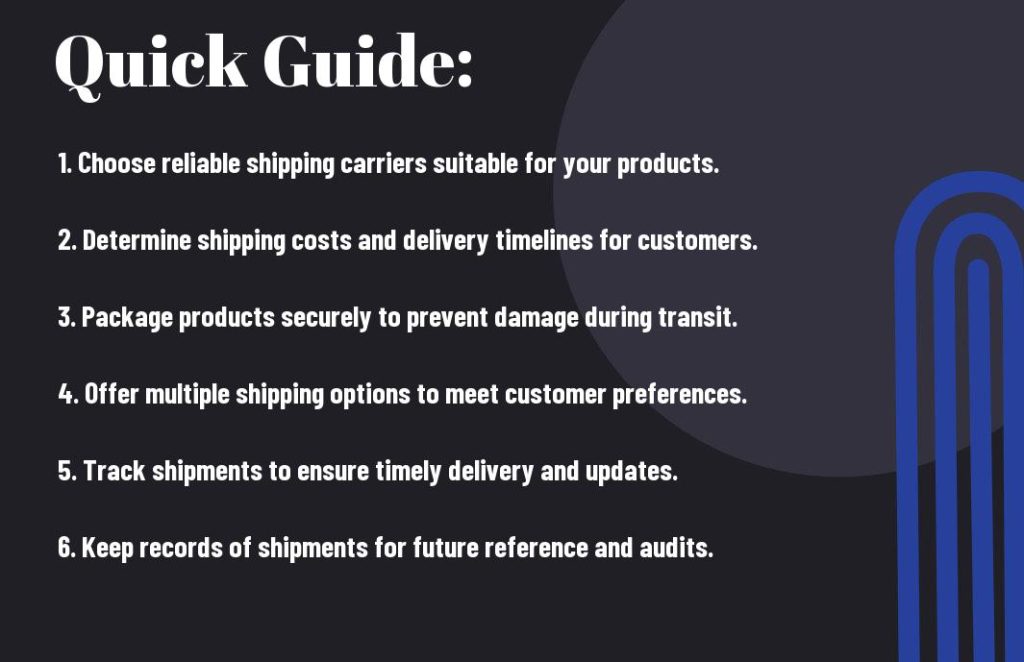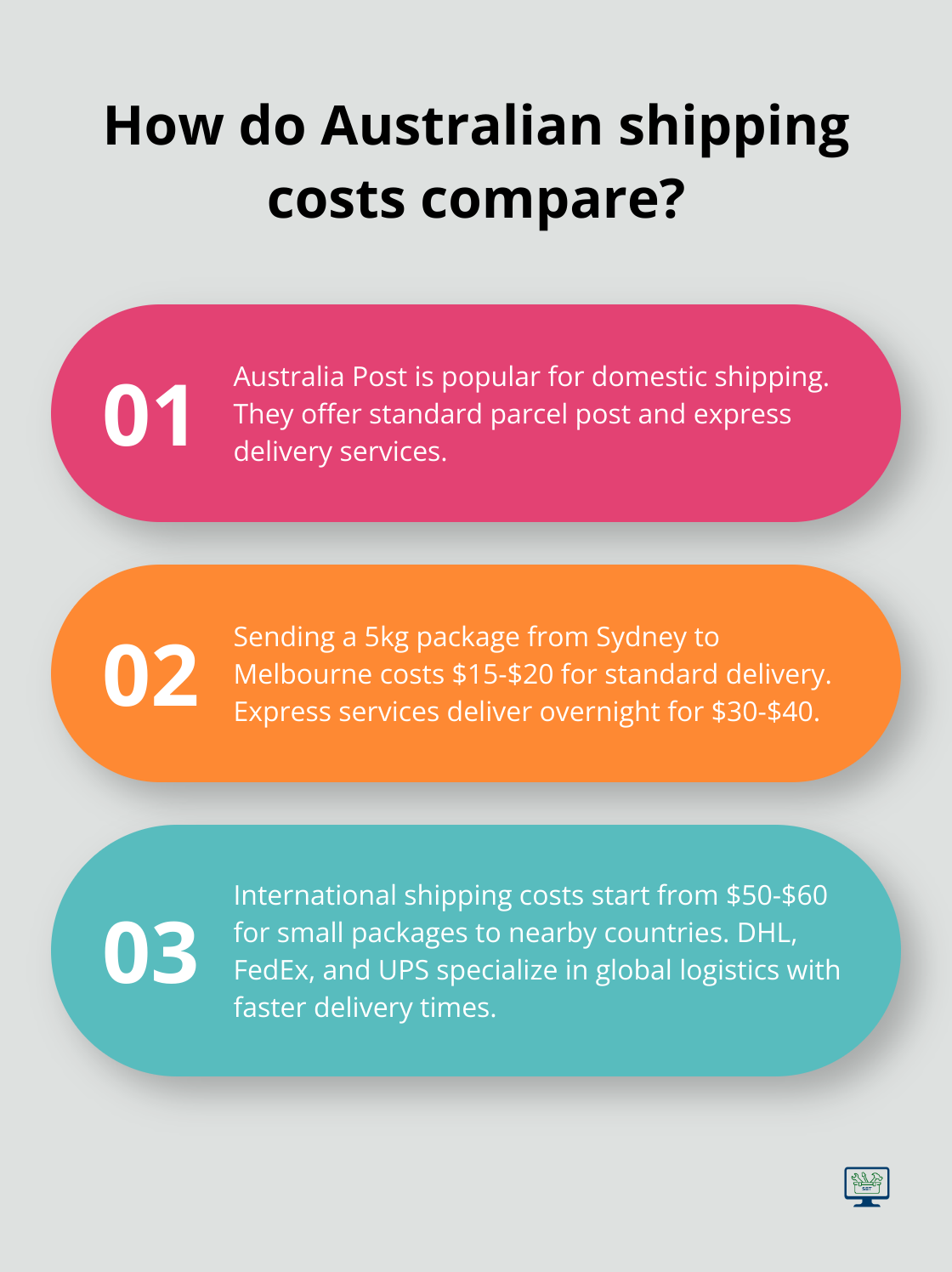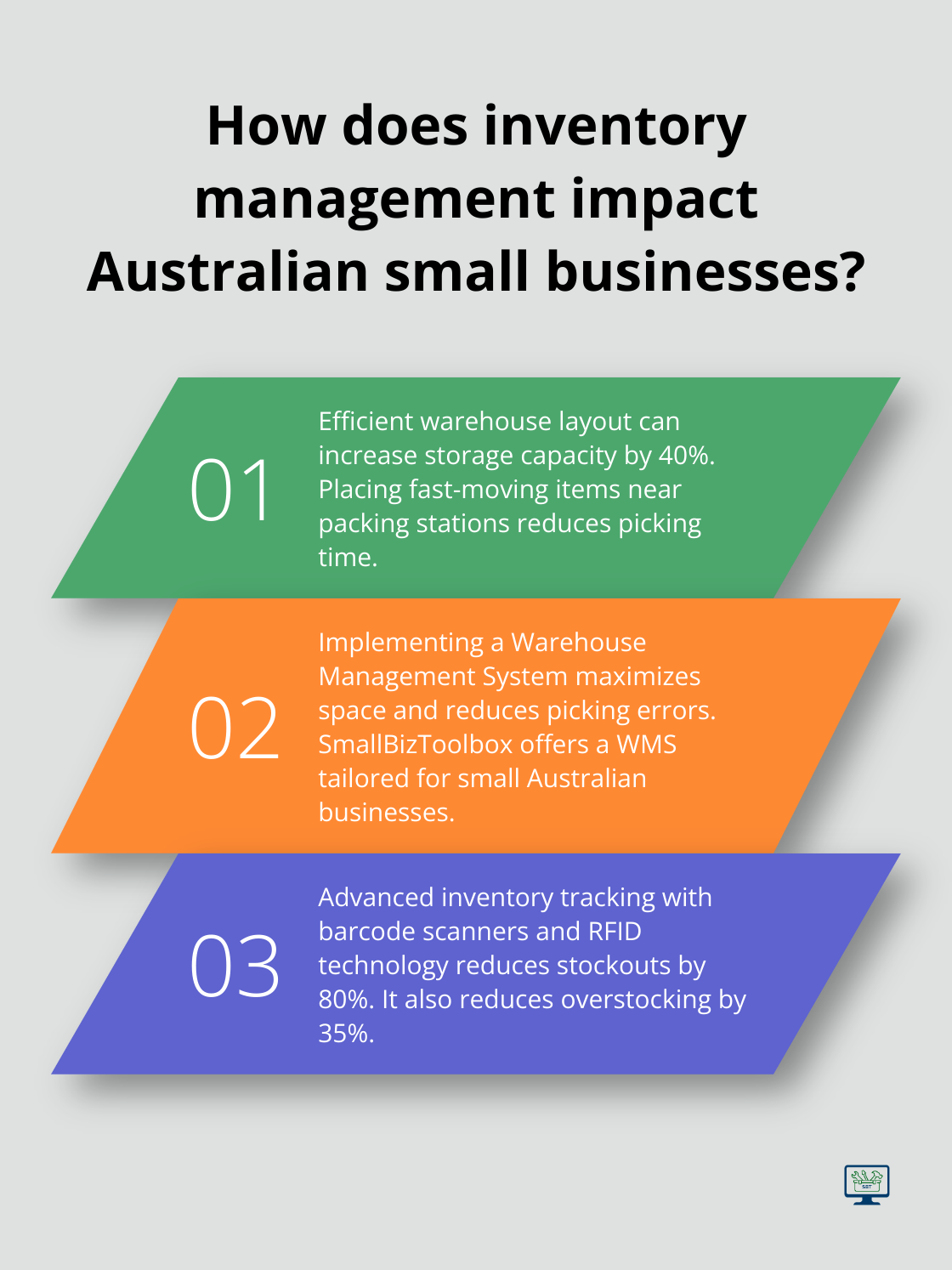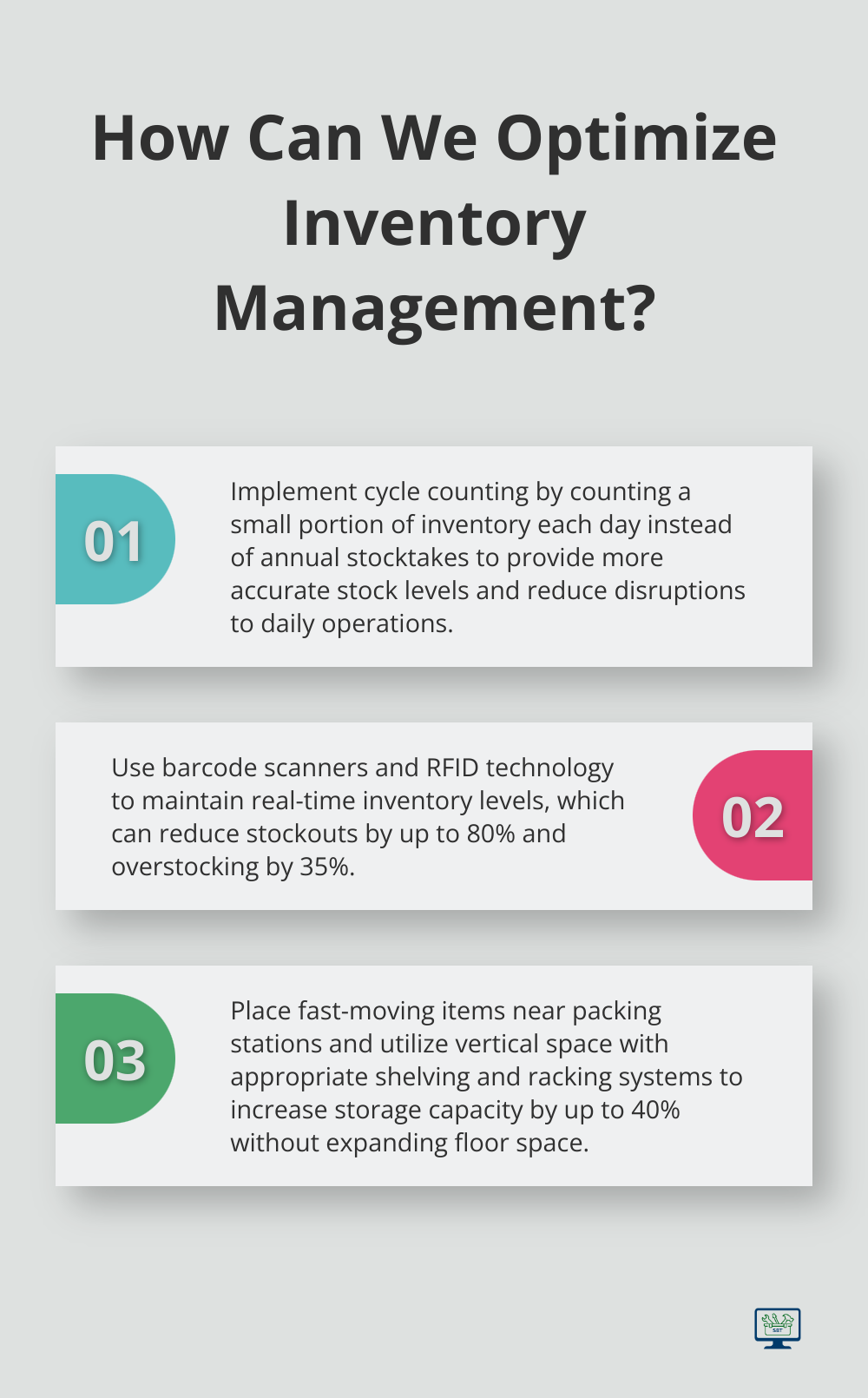Shipping and logistics can make or break a small business in Australia. At SmallBizToolbox, we’ve seen countless entrepreneurs struggle with the complexities of getting their products to customers efficiently and cost-effectively.
This guide will walk you through the essentials of small business logistics in Australia, from understanding shipping options to optimizing your processes. We’ll cover everything you need to know to streamline your operations and boost your bottom line.

Navigating Australian Shipping Options
Any option you choose should align with your goals for cost, speed, and service quality.
| Shipping Type | Details |
| Standard Shipping | Affordable option for non-urgent deliveries. |
| Express Shipping | Faster option, typically 1-3 business days. |
| Same-Day Delivery | Ideal for urgent or local deliveries. |
| Freight Shipping | Best for large or bulk shipments. |
| Parcel Tracking Services | Provides real-time status updates on deliveries. |
Domestic vs. International Shipping
Australia Post stands out as a popular choice for domestic shipping within Australia. They offer various services, from standard parcel post to express delivery. However, courier services like Sendle or Aramex often provide competitive rates for certain package sizes and destinations.
International shipping from Australia presents unique challenges. While Australia Post offers international services, companies like DHL, FedEx, and UPS specialize in global logistics. These carriers often provide faster delivery times and more robust tracking systems (essential for maintaining customer satisfaction in cross-border sales).
Carrier Services and Specializations
Each major carrier in Australia has its strengths. StarTrack, owned by Australia Post, excels in business-to-business deliveries and offers tailored solutions for e-commerce. Toll prioritizes freight and parcel services for businesses of all sizes, with a strong presence in rural areas.

For perishable goods, companies like Refrigerated Roadways specialize in temperature-controlled transport. This specialization proves essential for businesses in the food and beverage industry or those shipping temperature-sensitive products.
Cost and Delivery Time Comparisons
Shipping costs in Australia vary widely based on factors like distance, package size, and delivery speed. As a general rule, metro-to-metro deliveries cost less, while shipping to rural areas can significantly increase prices.
For example, sending a 5kg package from Sydney to Melbourne might cost around $15-$20 with standard delivery (taking 2-3 business days). Express services could deliver the same package overnight for $30-$40. International shipping costs start much higher, with prices beginning from $50-$60 for small packages to nearby countries like New Zealand.
To optimize costs, offer customers multiple shipping options. Businesses that provide both standard and express shipping options often see increased customer satisfaction compared to those offering a single option.
The cheapest option isn’t always the best. Reliability and customer service should factor into your decision. A late or damaged delivery can cost you more in the long run through lost customers and negative reviews.
Don’t underestimate the power of negotiation. If you ship in volume, reach out to carriers directly. Many offer discounted rates for businesses with consistent shipping needs, which can lead to significant savings over time.
Optimizing Your Shipping Strategy
To create an effective shipping strategy, analyze your product range, target market, and business goals. Consider factors such as product weight, dimensions, and fragility when selecting carriers and services.
Try to balance speed and cost. While fast shipping can improve customer satisfaction, it also increases expenses. Find the sweet spot that meets customer expectations without eating into your profits.
Lastly, stay informed about industry trends and changes in carrier policies. The shipping landscape evolves rapidly, and staying ahead of these changes can give you a competitive edge.
As we move forward, let’s explore how to streamline your shipping process for maximum efficiency and customer satisfaction.
How to Streamline Your Shipping Process
Efficient shipping processes can significantly impact your business’s bottom line and customer satisfaction. Let’s explore how to optimize these processes for substantial growth in your Australian small business.
Pros and Cons of Different Shipping Methods
After considering various shipping methods, it’s important to weigh their advantages and disadvantages. Each method has its own set of pros and cons that can impact your business. Below is a breakdown of the different shipping options you can choose from:
| Shipping Method | Pros and Cons |
|---|---|
| Express Shipping | Fast delivery, reliable tracking |
| Standard Shipping | Cost-effective, easy setup |
| Freight Shipping | Ideal for large items, bulk shipping discounts |
| Local Courier Services | Quick delivery, personal touch |
| International Shipping | Able to reach global customers, increasing market |
| Drone Delivery | Innovative, potential for rapid service |
| Drop Shipping | No inventory risk, easy to start |
| Flat Rate Shipping | Simplified pricing model, predictable costs |
| Same Day Delivery | Immediate service, attracts customers |
Selecting the Right Packaging
The choice of appropriate packaging protects your products and minimizes shipping costs. For fragile items, invest in sturdy boxes and cushioning materials like bubble wrap or air pillows. Poly mailer bags offer a lightweight, cost-effective solution for clothing or non-breakable items.

Consider the environmental impact of your packaging choices. About 77% of consumers look into sustainability elements when shopping online and want brands to communicate their sustainability efforts. Opt for recyclable or biodegradable materials to appeal to eco-conscious customers.
Streamlining Order Fulfillment
Efficient order fulfillment starts with organized inventory management. Implement a system where fast-moving items are easily accessible. This simple step can reduce picking time significantly.
Batch processing is another effective strategy. Instead of fulfilling orders as they come in, set specific times during the day to process multiple orders at once. This method increases productivity by reducing repetitive tasks and minimizing errors.
Leveraging Technology for Shipping Efficiency
Shipping software and automation tools are game-changers for small businesses. These platforms compare rates across multiple carriers, automatically generate shipping labels, and provide real-time tracking information to customers.
Consider integrating your e-commerce platform with your shipping software. This integration automatically updates inventory levels and order statuses, reducing manual data entry and the potential for errors.
While many shipping software options exist, SmallBizToolbox offers a comprehensive solution tailored specifically for Australian small businesses. Our platform integrates seamlessly with popular e-commerce systems and provides access to discounted rates from major carriers.
Optimizing your shipping process requires ongoing effort. Review your strategies regularly and stay informed about new technologies and industry trends. This continuous refinement positions you well to meet evolving customer needs and stay ahead of the competition.
Now that we’ve covered how to streamline your shipping process, let’s move on to managing logistics and inventory effectively in the next chapter.
How to Master Logistics and Inventory Management
Optimize Warehouse Layout
Efficient warehouse layout is key for small businesses in Australia. Place fast-moving items near packing stations to reduce picking time. Use vertical space with appropriate shelving and racking systems. This approach can increase storage capacity by up to 40% without expanding floor space.

Implement a Robust Warehouse Management System
A good Warehouse Management System (WMS) can maximize space, reduce picking errors, optimize fulfillment routes, and maintain flexibility. Many options exist in the market, but SmallBizToolbox offers a user-friendly WMS tailored for small Australian businesses.
Utilize Advanced Inventory Tracking
Accurate inventory tracking is essential. Use barcode scanners and RFID technology to maintain real-time inventory levels. This can reduce stockouts by up to 80% and overstocking by 35%.
Master Inventory Forecasting
Analyze historical sales data alongside market trends for accurate forecasting. The Australian Bureau of Statistics provides valuable industry reports to inform your predictions. In November 2024, the monthly business turnover indicator showed a 2.0% rise in the 13-industry aggregate, with rises seen in 10 industries. Try to maintain just enough stock to meet demand without tying up excessive capital in inventory.
Consider Cycle Counting
Implement cycle counting instead of annual stocktakes. Count a small portion of inventory each day to provide more accurate stock levels and reduce disruptions to daily operations.
Evaluate In-house vs Outsourced Logistics
The choice between in-house and outsourced logistics depends on various factors. In-house logistics offers more control but requires significant investment in infrastructure and staff. It suits businesses with steady, predictable demand.

Outsourcing to a third-party logistics provider (3PL) can be cost-effective for growing businesses. 3PLs in Australia typically charge 5-7% of the product value for their services. This option provides scalability and access to advanced technology without large upfront costs.
A hybrid approach might work best. Manage core products in-house and outsource seasonal or slow-moving items. This strategy can optimize costs while maintaining control over key products.
Final Thoughts
Logistics Management Steps
| Step | Description |
|---|---|
| 1. Assess Your Needs | Evaluate your product types, sizes, and shipping frequency. |
| 2. Plan Your Shipping Strategy | Decide on shipping methods, costs, and timelines. |
| 3. Select the Right Courier Service | Choose a reliable courier based on your shipping requirements. |
| 4. Monitor Shipments | Keep track of your shipments to ensure timely delivery. |
Small business logistics in Australia requires continuous improvement and adaptation. You must understand your shipping options, streamline processes, and manage inventory effectively to create a robust strategy. Regular assessment of carrier options and openness to new technologies will enhance your efficiency in this rapidly evolving landscape.

Inventory management forms the backbone of smooth operations. You should maintain optimal stock levels while minimizing costs, whether you choose in-house management or partner with a 3PL. Data-driven forecasting and cycle counting will help you achieve more accurate inventory tracking.
SmallBizToolbox offers comprehensive tools and resources to support your shipping and logistics needs. Our platform provides solutions to optimize your operations (from inventory management systems to carrier rate comparisons). You can turn your shipping and logistics processes into a competitive advantage by focusing on efficiency and staying informed about industry trends.
FAQ
Q: What are the best shipping options available for my products in Australia?
A: In Australia, there are various shipping options to consider based on your business needs. Popular choices include Australia Post, which offers reliable domestic and international services at competitive rates. Other options include CouriersPlease, Fastway, and TNT, which provide faster services and can handle larger packages. It’s advisable to compare rates and services to choose the best fit for your business, considering factors such as delivery speed, package size, and destination. You may also explore third-party logistics (3PL) providers that can manage shipping, warehousing, and fulfillment for you.
Q: How do I determine shipping costs for my products?
A: To determine shipping costs, you need to consider the dimensions and weight of your package, the shipping method chosen, and the destination. Most shipping services have online calculators where you can input these details to get an estimated shipping rate. Additionally, take into account any packaging materials needed, which can impact the overall shipping cost. It’s wise to remain aware of any additional fees, like fuel surcharges, which some carriers may apply based on distance or fluctuating gas prices.
Q: What logistics considerations should I focus on to ensure timely delivery of my products?
A: To ensure timely delivery, you should focus on several key logistics considerations. First, optimize your inventory management by keeping track of stock levels and anticipating demand to prevent delays. Second, streamline your fulfillment process by choosing reliable suppliers and thoroughly training your staff on handling and packaging products efficiently. Additionally, establish clear communication channels with your shipping provider to stay updated on delivery timelines and any potential disruptions. Regularly review your shipping strategies to make adjustments that can improve delivery speed and customer satisfaction.
How useful was this Resource?
Click on a star to rate it!
Average rating 0 / 5. Vote count: 0
No votes so far! Be the first to rate this post.
We are sorry that this post was not useful for you!
Let us improve this Resource!
Tell us how we can improve this Resource?




